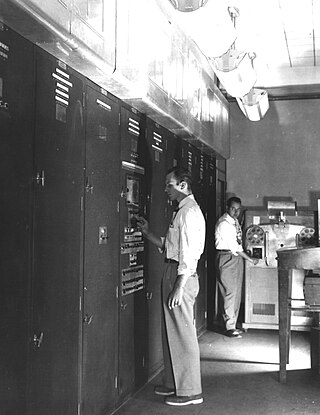
EDVAC was one of the earliest electronic computers. It was built by Moore School of Electrical Engineering, Pennsylvania. Along with ORDVAC, it was a successor to the ENIAC. Unlike ENIAC, it was binary rather than decimal, and was designed to be a stored-program computer.
BINAC was an early electronic computer designed for Northrop Aircraft Company by the Eckert–Mauchly Computer Corporation (EMCC) in 1949. Eckert and Mauchly, though they had started the design of EDVAC at the University of Pennsylvania, chose to leave and start EMCC, the first computer company. BINAC was their first product, the first stored-program computer in the United States; BINAC is also sometimes claimed to be the world's first commercial digital computer even though it was limited in scope and never fully functional after delivery.

Whirlwind I was a Cold War-era vacuum tube computer developed by the MIT Servomechanisms Laboratory for the U.S. Navy. Operational in 1951, it was among the first digital electronic computers that operated in real-time for output, and the first that was not simply an electronic replacement of older mechanical systems.
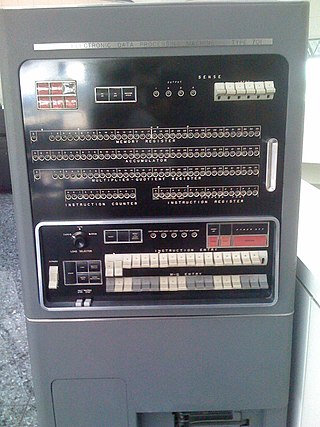
The IBM 701 Electronic Data Processing Machine, known as the Defense Calculator while in development, was IBM’s first commercial scientific computer and its first series production mainframe computer, which was announced to the public on May 21, 1952. It was invented and developed by Jerrier Haddad and Nathaniel Rochester based on the IAS machine at Princeton.

The IAS machine was the first electronic computer built at the Institute for Advanced Study (IAS) in Princeton, New Jersey. It is sometimes called the von Neumann machine, since the paper describing its design was edited by John von Neumann, a mathematics professor at both Princeton University and IAS. The computer was built from late 1945 until 1951 under his direction. The general organization is called von Neumann architecture, even though it was both conceived and implemented by others. The computer is in the collection of the Smithsonian National Museum of American History but is not currently on display.

The ORDVAC, is an early computer built by the University of Illinois for the Ballistic Research Laboratory at Aberdeen Proving Ground. A successor to the ENIAC. It was based on the IAS architecture developed by John von Neumann, which came to be known as the von Neumann architecture. The ORDVAC was the first computer to have a compiler. ORDVAC passed its acceptance tests on March 6, 1952, at Aberdeen Proving Ground in Maryland. Its purpose was to perform ballistic trajectory calculations for the US Military. In 1992, the Ballistic Research Laboratory became a part of the U.S. Army Research Laboratory.
The ORACLE or Oak Ridge Automatic Computer and Logical Engine, an early computer built by Oak Ridge National Laboratory, was based on the IAS architecture developed by John von Neumann.
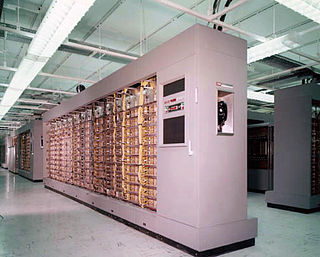
The AN/FSQ-7 Combat Direction Central, referred to as the Q7 for short, was a computerized command and control system for Cold War ground-controlled interception used in the USAF Semi-Automatic Ground Environment (SAGE) air defense network.
The Mercury was an early commercial computer from the mid-1950s built by Ferranti. It was the successor to the Ferranti Mark 1, adding a floating point unit for improved performance, and increased reliability by replacing the Williams tube memory with core memory and using more solid-state components. The computer had roughly 2000 vacuum tubes and 2000 germanium diodes. Nineteen Mercuries were sold before Ferranti moved on to newer designs.
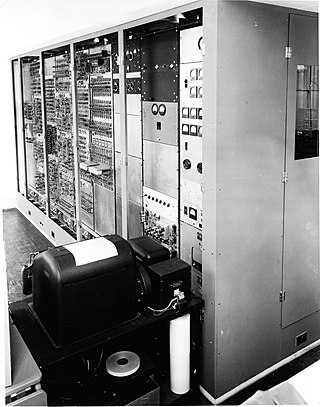
SEAC was a first-generation electronic computer, built in 1950 by the U.S. National Bureau of Standards (NBS) and was initially called the National Bureau of Standards Interim Computer, because it was a small-scale computer designed to be built quickly and put into operation while the NBS waited for more powerful computers to be completed. The team that developed SEAC was organized by Samuel N. Alexander. SEAC was demonstrated in April 1950 and was dedicated in June 1950; it is claimed to be the first fully operational stored-program electronic computer in the US.
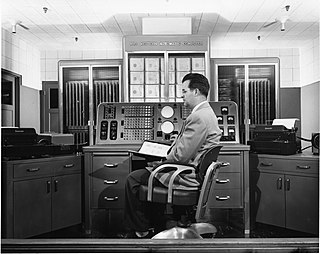
The SWAC was an early electronic digital computer built in 1950 by the U.S. National Bureau of Standards (NBS) in Los Angeles, California. It was designed by Harry Huskey.

DYSEAC was the second Standards Electronic Automatic Computer.

The Harvard Mark III, also known as ADEC was an early computer that was partially electronic and partially electromechanical. It was built at Harvard University under the supervision of Howard Aiken for the U.S. Navy.
CALDIC was an electronic digital computer built with the assistance of the Office of Naval Research at the University of California, Berkeley between 1951 and 1955 to assist and enhance research being conducted at the university with a platform for high-speed computing.
The Z5 was a computer designed by Konrad Zuse and manufactured by Zuse KG following an order by Ernst Leitz GmbH in Wetzlar in 1950. The computer was delivered in July 1953 and was the first commercial built-to-order mainframe in Germany. The computer was purchased to help with the design of optical lens systems.
FLAC, the Florida Automatic Computer, was an early digital electronic computer built for the United States Air Force at Patrick Air Force Base (PAFB) in Brevard County of Florida, to perform missile data reduction. The computer began service in 1953.

The IBM Naval Ordnance Research Calculator (NORC) was a one-of-a-kind first-generation computer built by IBM for the United States Navy's Bureau of Ordnance. It went into service in December 1954 and was likely the most powerful computer at the time. The Naval Ordnance Research Calculator (NORC), was built at the Watson Scientific Computing Laboratory under the direction of Wallace Eckert.

A vacuum-tube computer, now termed a first-generation computer, is a computer that uses vacuum tubes for logic circuitry. Although superseded by second-generation transistorized computers, vacuum-tube computers continued to be built into the 1960s. These computers were mostly one-of-a-kind designs.
Philco was one of the pioneers of transistorized computers. After the company developed the surface barrier transistor, which was much faster than previous point-contact types, it was awarded contracts for military and government computers. Commercialized derivatives of some of these designs became successful business and scientific computers. The TRANSAC Model S-1000 was released as a scientific computer. The TRANSAC S-2000 mainframe computer system was first produced in 1958, and a family of compatible machines, with increasing performance, was released over the next several years.

The Model V was among the early electromechanical general purpose computers, designed by George Stibitz and built by Bell Telephone Laboratories, operational in 1946.












